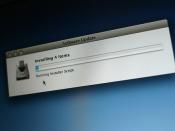A database stores keyed information in an organized and accessible manner. The size and capacity of databases can vary widely, from a small database used by an individual to file phone numbers, to an extremely large enterprise database that stores several gigabytes of information accessed by thousands of individuals. Databases are essential for almost every company in today's business world. Database can help us keep track of, inventory, billing, pay role, phone numbers and much more. Lacking the use of databases, work will take longer to accomplish. Another great feature about having a database in place is that a record of all transitions can be kept for auditing and statistic reporting.
In this paper I will talk about the database and software used at my place of employment. The DBMS that we utilize is Oracle; it is running on an IBM Mid-range server and can be accessed from any workstation throughout the district.
The AS 400 Query language allows you to create reports for specific information form information stored in the system. A report is used to organize and convey information in a concise, easy-to-read format. Many reports are generated for department heads as they make decisions driven by data.
The main application that houses and manages the information collected is called CIMS. CIMS consist of several subsystems that work together and share information. These sub systems include: EMS Subsystem; Employee Management System, which transfer's information to the FMS; Financial Management System, which also exchanges information with the HMS; Human Resource management System, which is also linked to SMS; Student Management System.
I am most familiar with the SMS; Student Management System, which is used for many functions. SMS is used to create a mater schedule of courses; you can define each of the classes in your school,
![NASA Watching Atlantic Tropics: Katia, Tropical Storm Lee and System 94L [detail view]](https://s.writework.com/uploads/5/54638/nasa-watching-atlantic-tropics-katia-tropical-storm-lee-and-thumb.jpg)

